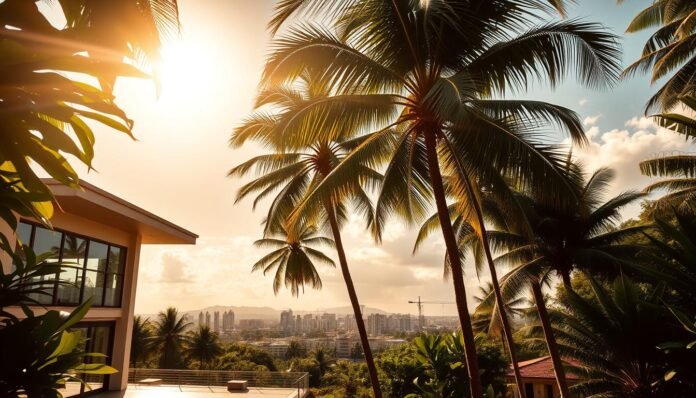In the heart of Central America, Costa Rica architects are redefining the landscape of tropical architecture by harmoniously blending luxury homes with sustainable design. These visionary professionals are not just creating stunning living spaces; they are crafting paradisiacal environments that reflect the vibrant cultural ethos of the region. The commitment to eco-friendly practices is evident in every detail, ensuring that their work not only showcases artistry but also promotes an enduring respect for nature.
From acclaimed firms like SARCO Architects to emerging talents, the architectural community in Costa Rica is at the forefront of innovative building techniques. Focusing on sustainability while catering to the desires of discerning homeowners, these architects are setting a new standard for what it means to live luxuriously amidst tropical beauty.
The Essence of Tropical Architecture
Tropical architecture embraces the principles of aesthetic design while harmonizing with the environment. This approach is characterized by open spaces and seamless connections between indoor and outdoor living. In Costa Rica homes, the inclusion of natural elements creates a sense of tranquility, reflecting the vibrant biodiversity of the region. Designs often feature large windows and sliding doors that invite lush landscapes inside, allowing residents to enjoy the surrounding beauty.

Examples of tropical architecture in Costa Rica showcase this unique blend of nature and human creativity. Structures like the Villa Paraiso and Casa de la Montaña illustrate how local flora and fauna inspire architectural choices. These homes not only provide shelter but also enhance the living experience through carefully thought-out connections with the environment. The innovative use of materials emphasizes sustainability while promoting an aesthetic that resonates with the natural world. Each architectural project embodies the essence of tropical living, celebrating the region’s vibrant landscape and fostering a deeper connection between people and nature.
Costa Rica Architects: Leading the Way in Sustainable Design
Costa Rica architects are at the forefront of sustainable architecture, crafting eco-friendly buildings that harmonize with the environment. These professionals embrace innovative approaches to building that not only prioritize energy efficiency but also reduce the overall environmental footprint. By employing green building techniques, they create homes and structures that reflect a commitment to sustainability and ecological responsibility.
Innovative Approaches to Eco-friendly Building
The use of advanced green building techniques allows Costa Rica architects to maximize natural resources while minimizing waste. Through strategies such as passive solar design and rainwater harvesting, these architects optimize buildings’ energy consumption and resource management. Such approaches serve as a guide for those seeking to balance modern living with environmental stewardship.
Local Materials and Sustainability Practices
Utilizing local materials is vital for the creation of sustainable architecture in Costa Rica. Sustainably sourced wood and natural stone are not only aesthetically pleasing but also significantly reduce the carbon footprint associated with transportation. By incorporating these materials, architects can ensure that the structures blend seamlessly into their surroundings while promoting local economies. This commitment to local resources highlights the essential role of Costa Rica architects in fostering a greener future.
The SARCO Architects Costa Rica Experience
SARCO Architects stands as a beacon of innovation and quality within Costa Rica’s architectural landscape. With nearly five decades of experience, the firm has cultivated a reputation for crafting exquisite environments that harmonize with their tropical surroundings. Their extensive portfolio showcases a commitment to sustainable luxury living, ensuring that every project reflects both aesthetic appeal and ecological mindfulness.
Introduction to SARCO Architects
The journey of SARCO Architects began with a vision to redefine architectural excellence in Costa Rica. Over the years, they have demonstrated unparalleled expertise, adapting to changing design trends while staying true to their core values of creativity and sustainability. Recognized for their innovative solutions, SARCO Architects continually strive to enhance the architectural experience for their clients, from concept to completion.
Overview of the SARCO System™
The SARCO System™ revolutionizes the construction process by integrating design with advanced technology. This unique approach simplifies project management, allowing clients to participate seamlessly in the development of their dream homes. Emphasizing clarity and efficiency, the SARCO System™ ensures that clients, even those living abroad, can engage in real-time updates, making the journey less daunting while maintaining a high level of satisfaction.
Mastering Tropical Modern Home Design
Crafting a modern home design that harmonizes with the lush landscapes of Costa Rica involves a delicate balance between luxury living and environmental respect. Architects have embraced innovative techniques to create spaces that exude elegance while remaining connected to nature. This approach signifies a movement towards sustainable luxury, where opulence does not come at the expense of the earth.
Balancing Luxury and Nature
Modern home design in tropical settings thrives on integrating natural elements with upscale features. Designers leverage local materials to enhance both aesthetic appeal and sustainability. Large windows invite natural light and views of verdant surroundings into gracious spaces. This deliberate connection fosters a serene living environment that embodies luxury while respecting the local ecosystem.
Award-Winning Projects and Recognitions
Several architects and firms in Costa Rica have garnered attention for their award-winning architecture. They showcase projects that not only achieve visual splendor but also demonstrate commitment to ecological principles. Each recognition serves as a testament to their ability to fuse luxury living with sustainable practices. Such achievements inspire future projects, reinforcing the notion that luxury can align seamlessly with environmental responsibility.
Villa Avellana: A Showcase of Architectural Excellence
Nestled in a breathtaking landscape, Villa Avellana exemplifies architectural excellence through its stunning design and luxurious features. This luxury villa harmonizes sophisticated aesthetics with natural beauty, making it a remarkable addition to Costa Rica’s architectural scene. The project’s design elements create a seamless integration with the surrounding environment, allowing occupants to experience the tropical landscape while enjoying high-end living.
Design Elements and Features
Villa Avellana boasts a range of exceptional design elements that highlight its architectural brilliance. Expansive floor-to-ceiling windows invite natural light and frame sweeping views of lush greenery, blurring the boundaries between indoors and outdoors. The use of natural materials, like locally sourced stone and FSC Certified Teak wood, enriches the overall ambiance while promoting sustainability. Spacious terraces and infinity pools reflect a commitment to luxurious outdoor living, offering a perfect sanctuary for relaxation and entertainment.
Sustainable Practices Incorporated into Villa Avellana
Sustainability lies at the core of Villa Avellana’s design philosophy. The incorporation of innovative energy-efficient technologies, including solar panels and smart home systems, minimizes the environmental footprint while enhancing comfort. Rainwater harvesting systems and tropical landscaping further emphasize sustainable practices, demonstrating a responsible approach to luxury living. Villa Avellana not only represents an impressive architectural feat but also stands as a model for eco-conscious development, showcasing how luxury and sustainability can go hand in hand.
Embracing the Pura Vida Lifestyle
The essence of the Pura Vida lifestyle permeates every aspect of Costa Rica living, including its architecture. This philosophy encapsulates values of happiness, relaxation, and simplicity, which resonate deeply within the cultural fabric of the country. As architects in Costa Rica create homes and spaces, they draw inspiration from this joyful ethos, crafting designs that reflect the harmony between nature and the human experience.
How Architecture Reflects Cultural Values
Architectural reflection in Costa Rica showcases the cultural values that define the Pura Vida lifestyle. Homes are designed with open spaces that encourage connection with the outdoors, emphasizing natural light and ventilation. Local materials often feature prominently, allowing structures to blend seamlessly into their surroundings. This approach not only supports sustainable practices but also resonates with the Costa Rican principle of living in harmony with nature. The designs invite residents to embrace a slower pace of life, fostering tranquility and relaxation, which are key components of the Pura Vida lifestyle.
Studio Saxe: Innovation in Coastal Living
Studio Saxe represents a remarkable force in the architecture of Costa Rica, particularly in the realm of coastal living. Their designs prioritize harmony with the natural environment and eloquently reflect the principles of architectural innovation. By creating spaces that seamlessly blend with the landscape, they play a significant role in enhancing the coastal living experience for residents.
Integration with Natural Surroundings
The emphasis on natural integration is evident in every project Studio Saxe undertakes. Their approach involves studying the local ecosystem and climate to craft buildings that not only reside within the coastal context but also celebrate it. Facilities feature materials and configurations that respect the landscape, ensuring that homes feel like a part of their surroundings rather than imposing structures.
Examples of Studio Saxe’s Notable Projects
Noteworthy projects, such as their condominiums in Nosara, exemplify this philosophy. These residences showcase architectural innovation through large openings that invite natural light and ocean breezes, allowing inhabitants to fully immerse themselves in the coastal experience. Each design detail, from open living spaces to sustainable materials, fosters connections between residents and their breathtaking environment.
Creating Community with Architecture
In Costa Rica, the architects’ role extends beyond mere construction. These professionals shape environments that foster community development through thoughtful design aimed at connecting spaces for social interaction. By integrating public areas and residential projects, architects contribute to building neighborhoods that facilitate a sense of belonging and collective identity.
The Role of Architects in Community Development
Architects in Costa Rica play a crucial role in community development by crafting spaces that encourage engagement among residents. Their designs often include parks, plazas, and communal areas, which serve as gathering spots for activities and events. Through innovative planning, architects create environments that promote social ties and enhance the quality of life for residents. This approach not only beautifies the landscape but also strengthens community bonds.
Architectural Projects that Foster Connection
Numerous architectural projects in Costa Rica exemplify this philosophy, showcasing how design can unify communities. For instance, developments that feature open spaces and multi-functional areas allow people to connect and interact easily. These projects often prioritize accessibility and inclusivity, ensuring that everyone can enjoy and participate in community activities. The transformative power of Costa Rica architecture in fostering neighborhoods highlights the significance of the architects’ role in building vibrant, linked communities.
Challenges Unique to Tropical Architecture
Tropical architecture presents a variety of challenges that architects must navigate to create functional and aesthetically pleasing structures. Humidity, heavy rainfall, and the presence of wildlife are just a few factors that impact Costa Rica construction. Addressing these tropical architecture challenges requires innovative approaches that prioritize resilience and sustainability while ensuring the comfort of the inhabitants.
Environmental Considerations and Solutions
In tropical climates, architects face the challenge of designing homes that can endure extreme weather conditions. Strategies such as incorporating raised foundations help combat flooding risks, while utilizing breathable materials enhances airflow and mitigates humidity issues. These environmental solutions not only preserve the integrity of the buildings but also create a comfortable living space that harmonizes with the surrounding landscape.
Using local materials in construction further supports the idea of sustainability. This practice reduces transportation emissions and allows designs to blend seamlessly with their natural environment. By embracing these methods, architects in Costa Rica can overcome the unique challenges presented by the tropical setting while celebrating its beauty and biodiversity.
The Future of Architecture in Costa Rica
The architectural landscape of Costa Rica is on the brink of transformation, driven by future architecture that integrates innovative solutions and sustainable practices. Emerging trends clearly indicate a shift towards smarter, more efficient designs that cater to both environmental needs and lifestyle preferences. As architects in Costa Rica explore the possibilities presented by technology in design, they are ushering in a new era of construction that respects the natural surroundings while prioritizing modern conveniences.
Emerging Trends and Technologies
In recent years, the integration of smart home technologies has gained significant traction in Costa Rica. These advancements offer homeowners enhanced control over their living environments, improving energy efficiency and comfort. Bioclimatic designs are becoming more prevalent, optimizing the use of natural resources while maintaining a connection to the stunning landscapes. The emphasis on renewable energy integrations reflects a commitment to sustainability, ensuring that future projects are not just stylish but also environmentally responsible. Architects and designers in Costa Rica are poised to lead this charge, fostering a culture of innovation that embraces the complexities of modern living.
Conclusion
Costa Rica architects are at the forefront of architectural innovation, skillfully blending luxury with sustainable design. As they create tropical living environments, these professionals emphasize the importance of environmental sensitivity without compromising aesthetic value. Each project reflects a commitment to making beautiful, yet sensible choices that honor the natural surroundings.
Their ability to incorporate local materials and cultural influences results in distinctive architectural masterpieces that resonate with the essence of Costa Rica. The commitment to sustainable practices not only enhances the beauty of the structures but also strengthens the relationship between residents and the stunning landscapes that surround them.
In summary, the architectural landscape of Costa Rica serves as a testament to the potential of combining modern design with eco-conscious practices. As more Costa Rica architects continue to innovate, the nation stands as a vibrant example of how luxurious living and sustainability can harmoniously coexist, inviting all to embrace this paradise.
FAQ
What defines tropical architecture in Costa Rica?
Tropical architecture in Costa Rica is characterized by open spaces, seamless indoor-outdoor transitions, and the use of natural materials that enhance the connection to the surrounding environment. These unique aesthetics are influenced by the region’s rich cultural heritage and biodiversity.
How do architects in Costa Rica prioritize sustainability in their designs?
Costa Rican architects implement eco-friendly practices by using innovative building methods that focus on energy efficiency, incorporating sustainable local materials like FSC Certified woods and natural stone, and designing homes that minimize environmental impact while maximizing comfort and beauty.
What is the SARCO System™ and how does it benefit clients?
The SARCO System™ is a streamlined design and construction process developed by SARCO Architects. It ensures a clear and efficient journey for clients envisioning their dream homes, making it easier to manage projects from a distance and maintain high standards of sustainable luxury.
How do luxury and nature coexist in modern Costa Rican home design?
Architects in Costa Rica create dwellings that harmonize with nature by integrating luxurious elements while respecting the environment. This approach is evidenced in award-winning projects that emphasize sustainability and aesthetic appeal, leading to spaces that are both opulent and eco-conscious.
What are the notable features of Villa Avellana?
Villa Avellana stands out for its stunning landscape integration, luxurious accommodations, and sustainable features such as the use of FSC Certified Teak wood and innovative energy-efficient technologies. This project exemplifies the successful blend of luxury living and environmental responsibility.
How does architecture reflect the Pura Vida lifestyle?
The Pura Vida philosophy is embodied in the architectural designs of Costa Rican homes, fostering happiness, relaxation, and simplicity. Architects create inviting spaces that promote joyful living, echoing the cultural values associated with this cherished concept.
What characterizes the innovative designs by Studio Saxe?
Studio Saxe is known for its coastal designs that harmonize with the natural landscape. Their projects focus on environmental respect while enhancing the residents’ connection with their surroundings, showcasing creative solutions to integrate architecture with nature.
What role does architecture play in community building in Costa Rica?
Architecture serves as a catalyst for community development by creating thoughtfully designed public spaces and residential projects that promote social interaction and cohesion. Successful examples illustrate how architecture can unite neighborhoods and enhance community engagement.
What challenges do architects face in tropical environments?
Architects in tropical climates encounter challenges such as humidity, heavy rainfall, and interactions with wildlife. They address these by employing innovative design strategies and best practices that ensure resilience while maintaining the aesthetic appeal of their structures.
What are some emerging trends in architecture in Costa Rica?
Emerging architectural trends in Costa Rica include the integration of smart home technologies, bioclimatic designs, and renewable energy solutions. These innovations aim to create more sustainable, efficient buildings that align with the country’s commitment to environmental stewardship.




